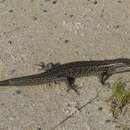en
names in breadcrumbs


White's skink (Liopholis whitii), also known commonly as White's rock skink, is a species of lizard in the family Scincidae. The species is endemic to Australia.
The specific name, whitii, is in honour of Irish surgeon and naturalist John White.[3]
L. whitii is widespread in south-eastern Australia, including Tasmania and many Bass Strait islands.[2]
The preferred natural habitats of L. whitii are forest, shrubland, and rocky areas, at altitudes from sea level to 1,200 m (3,900 ft).[1] White's skinks prefer a habitat with rocks, shrubby heathland and minimal human environmental disturbance. They also dig tunnels underground and have two entrances to the tunnel if needing an escape route. They also have well covered and hidden entrances to avoid predators.
The White's skink is a stocky slow-growing medium-sized species, growing to a maximum snout-to-vent length (SVL) of about 90 mm (3.5 in). They are mature at ~75 mm (3.0 in) (SVL) in both sexes. tTis size is typically achieved at three years,[4] but may be earlier in captivity.
Whites' skinks are omnivorous, capable of eating meat, insects and plant matter. They will also occasionally eat strawberries and raspberries.
They are variable in colour and pattern. Some populations display no back pattern and/or lip stripes. Their base colours found on the central stripe range from grey to brown and red.
The sides of their body is patterned with black and white rosettes backgrounded with a grey/brown gradient. Their underbelly is a pale peachy orange which increases in colour intensity towards the tail and on the underside of the limbs.
Their back is patterned with three bars, the middle being solid brown, and parallel on either side two black bars with white spots towered in a single sequence that terminates at the base of the head and tail. Their head and tail are typically brown with no patterning and minimal scale outlining present.
Most specimens have black stripes on both sides of their lips that run from their yellow-lined eye, down to a random speckling on the bottom of the chin. All individuals have varying lip patterns, and some do not have any at all.
E. whitii is highly variable and may be a complex of closely related species[5][6]
L. whitii are a burrowing polygynous (1 male per group of females) species, often digging or reusing complex tunnels. They live in small, sometimes temporary familial groups, with up to five females per male. However, the females do sometimes mate with males outside the group.[4]
They are a highly aggressive species that will viciously attack other individuals that they do not recognize or 'like' via scent. This includes outside females that the group could potentially include, making them very difficult to pair. Adults also will sometimes cannibalize rival juveniles they do not recognize, and this includes tails.
L. whitii are viviparous and give birth to live young.[2] Females will mate in September–October and give birth in late January–February over a period of two to ten days. Litter size ranges from 1–4.[4]
Offspring are highly aggressive from the start and will fight amongst themselves to chase away their rival neonates from the group. Juveniles will stay within the protection their family/parent until they reach about half the size of an adult. At this stage, the adult will chase the juvenile out of the group by attacking it on sight.
Two subspecies are recognized as being valid, including the nominotypical subspecies.[2]
Nota bene: A trinomial authority in parentheses indicates that the subspecies was originally described in a genus other than Egernia.
White's skink (Liopholis whitii), also known commonly as White's rock skink, is a species of lizard in the family Scincidae. The species is endemic to Australia.
Liopholis whitii Liopholis generoko animalia da. Narrastien barruko Scincidae familian sailkatuta dago.
Liopholis whitii Liopholis generoko animalia da. Narrastien barruko Scincidae familian sailkatuta dago.
Liopholis whitii est une espèce de sauriens de la famille des Scincidae[1].
Cette espèce est endémique d'Australie. Elle se rencontre au Queensland, en Nouvelle-Galles du Sud, en Australie-Méridionale, au Victoria, en Tasmanie et dans les nombreuses îles du détroit de Bass[1].
Il est à croissance lente, atteignant une longueur maximale d'environ 90 mm et peut prendre quatre ans pour atteindre sa maturité. Il donne naissance à des jeunes vivants. Il est très variable d'aspect et peut être un croisement d'espèces étroitement apparentées.
Selon Reptarium Reptile Database (10 octobre 2012)[2] :
Cette espèce est nommée en l'honneur de John White[3].
Liopholis whitii là một loài thằn lằn trong họ Scincidae. Loài này được Lacépède mô tả khoa học đầu tiên năm 1804.[1]
Liopholis whitii là một loài thằn lằn trong họ Scincidae. Loài này được Lacépède mô tả khoa học đầu tiên năm 1804.